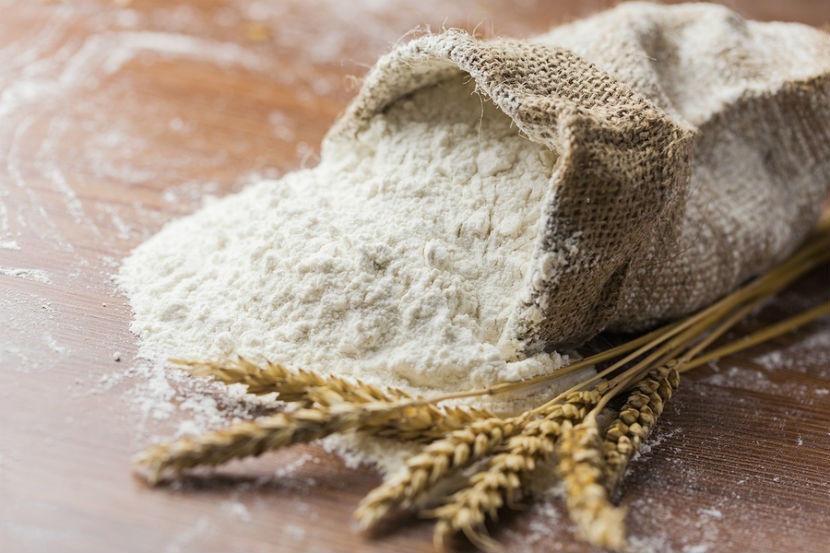
There are many types of flour we can use in home baking and some are more nutritious than others. This practical guide shows you how to buy, store, use and substitute different types of flour made from grains.
Types of flour
Flour can be made from grains, legumes, nuts, and even vegetables such as potato flour. This article reviews flours made with grains.
Whole grain flours
Whole grain flours have all three parts of the kernel (the bran, germ and endosperm) and are more nutritious than “refined” flours. Here is a list of whole grain flours:
-
Amaranth*
-
Barley
-
Brown rice*
-
Buckwheat*
-
Corn*
-
Millet*
-
Quinoa*
-
Rye
-
Spelt
*Gluten-free whole grain options
A note about whole wheat flour
Whole wheat flour is not a whole grain. It has some of the bran and most of the germ removed. Whole grain, whole wheat flour is a whole grain but is not widely available. Try a health food store to find this flour.
Refined wheat flours
These flours have the bran and germ removed, and are not as nutritious as whole grain flours.
-
Bread flour is made with “hard” wheat, which is higher in protein. The higher protein in this flour makes it ideal for yeast breads.
-
Pastry or cake flour is made with “soft” wheat, which is lower in protein. The lower protein in this flour makes it ideal for making tender cakes, cookies, pastries and pasta.
-
All purpose flour is made from a blend of “hard” and “soft” wheat grains. It is used to make a variety of baked goods including muffins, cakes, pastries and waffles.
Buying local flour
To know if your flour came from a farm in Ontario, look for the Foodland Ontario logo or contact the manufacturer. “Product of Canada” may also be listed on the package label. That tells you the flour came from a farm in Canada. When you buy local food, you support farmers so they can keep producing high quality, affordable food we can all enjoy.
Buy it best
-
Compare prices at the grocery store and bulk food store for the best deal on flours.
-
Do not buy flour from bulk food stores that smell musty. It may have gone bad.
Tips for storing flour
-
Store flour in a cool, dry place such as a pantry, fridge or freezer.
-
Once opened, transfer flour to an air-tight container.
-
Use by the “best before” or “sell by” date.
Nutrition
Canada’s Food Guide recommends we make at least half our grain choices whole grains. Substituting some whole grain flour for refined flour makes baked goods more nutritious. Whole wheat flour is not a whole grain but it does have more fibre than all purpose flour.
Tips for using different types of flour
For more nutritious yeast breads, replace ¼ of the all purpose flour with any of these flours:
Note: wheat germ can replace 1/3 of wheat flour in yeast breads. For more nutritious baked goods like muffins, scones or quick breads, replace ½ of the all purpose flour with any of these flours:
-
Barley
-
Buckwheat
-
Quinoa
-
Whole wheat
Give your baking a nutritional and flavourful boost. Choose whole grain recipes with:
-
Fruit (pumpkin, peaches, apples, berries, dates)
-
Vegetables (carrot, zucchini, sweet potato)
-
Nuts (walnuts, almonds and nut flours)
-
Seeds (flax, chia pumpkin, sunflower)
-
Fresh or dried herbs (basil, oregano, thyme, parsley)
5 things to do with flour
1. Make your own healthier baked goods like scones, muffins and quick breads. Your house will smell terrific and you’ll save money too. Try: Whole wheat orange ginger scones, Swedish knäckebröd or Flying Saucer Muffins
2. Make your own pizza dough, pancake and waffle mixes. It’s easy and you can choose better-for-you recipes too. Try these Masa Corn Pancakes or these Banana Whole Grain Griddle Cakes.
3. Thicken a stew. For a smooth, rich tasting stew with a thick broth, lightly flour and fry the meat before adding it to the liquid in the pot.
4. Make a cheese sauce. Over low heat, melt butter/margarine in a small pot. Whisk in an equal amount of all purpose flour to make a paste and keep stirring for a few minutes. Whisk in milk then grated cheese a little at a time until smooth.
5. Lightly dust greased baking sheets with flour. Your baked goods will release easily from the pan making clean up easier.
You may also be interested in
Choosing Whole Grains FAQs
All about Whole Grains
Last Update – May 10, 2017